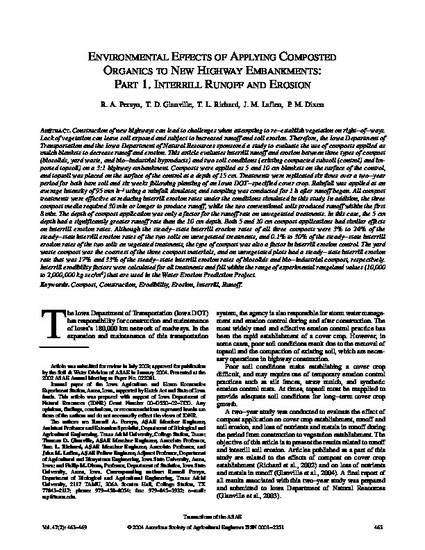
Construction of new highways can lead to challenges when attempting to re-establish vegetation on right-of-ways. Lack of vegetation can leave soil exposed and subject to increased runoff and soil erosion. Therefore, the Iowa Department of Transportation and the Iowa Department of Natural Resources sponsored a study to evaluate the use of composts applied as mulch blankets to decrease runoff and erosion. This article evaluates interrill runoff and erosion between three types of compost (biosolids, yard waste, and bio-industrial byproducts) and two soil conditions (existing compacted subsoil (control) and imported topsoil) on a 3:1 highway embankment. Composts were applied as 5 and 10 cm blankets on the surface of the control, and topsoil was placed on the surface of the control at a depth of 15 cm. Treatments were replicated six times over a two-year period for both bare soil and six weeks following planting of an Iowa DOT-specified cover crop. Rainfall was applied at an average intensity of 95 mm h-1 using a rainfall simulator, and sampling was conducted for 1 h after runoff began. All compost treatments were effective at reducing interrill erosion rates under the conditions simulated in this study. In addition, the three compost media required 30 min or longer to produce runoff, while the two conventional soils produced runoff within the first 8 min. The depth of compost application was only a factor for the runoff rate on unvegetated treatments. In this case, the 5 cm depth had a significantly greater runoff rate than the 10 cm depth. Both 5 and 10 cm compost applications had similar effects on interrill erosion rates. Although the steady-state interrill erosion rates of all three composts were 3% to 24% of the steady-state interrill erosion rates of the two soils on unvegetated treatments, and 0.1% to 30% of the steady-state interrill erosion rates of the two soils on vegetated treatments, the type of compost was also a factor in interrill erosion control. The yard waste compost was the coarsest of the three compost materials, and on unvegetated plots had a steady-state interrill erosion rate that was 17% and 33% of the steady-state interrill erosion rates of biosolids and bio-industrial compost, respectively. Interrill erodibility factors were calculated for all treatments and fell within the range of experimental rangeland values (10,000 to 2,000,000 kg sec/m4) that are used in the Water Erosion Prediction Project.
Available at: http://works.bepress.com/philip-dixon/10/

This article is from Transactions of the ASAE 47, no. 2 (2004): 463–469.